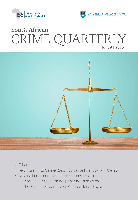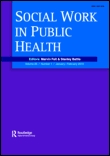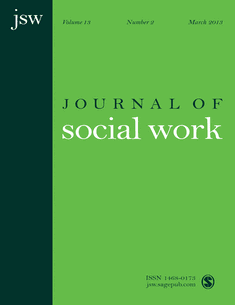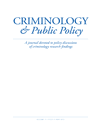
Safer Communities
Scope & Guideline
Advancing safety research for a brighter tomorrow.
Introduction
Aims and Scopes
- Community Safety and Crime Prevention:
The journal explores innovative strategies and interventions aimed at preventing crime and enhancing community safety, including community policing, environmental design, and youth engagement. - Social Justice and Inclusivity:
A strong emphasis is placed on social justice issues, particularly regarding marginalized and vulnerable populations. Research often examines the intersections of crime, social inequality, and community support systems. - Impact of Technology and Cybercrime:
The journal investigates the implications of technology on crime, including the rise of cybercrime and the role of digital interventions in crime prevention and community safety. - Hate Crimes and Victimization:
A significant focus is on understanding hate crimes and victimization across diverse communities, contributing to the discourse on social cohesion and legal responses. - Youth and Community Engagement:
Research frequently centers on youth-related issues, including their role in crime prevention, experiences within the justice system, and community-led initiatives for safety.
Trending and Emerging
- Digital Interventions and Cybersecurity:
An increasing number of studies are focusing on digital interventions aimed at enhancing community safety and addressing cybercrime, emphasizing the need for effective online crime prevention strategies. - Environmental Justice and Safety:
Research is increasingly addressing the intersection of environmental issues and community safety, exploring how environmental justice impacts crime rates and community resilience. - Youth-Led Initiatives and Participation:
There is a growing trend towards youth-led safety initiatives, highlighting the importance of engaging young people in co-designing solutions for violence prevention and community well-being. - Hate Crimes and Social Cohesion:
A surge in research on hate crimes, particularly in relation to marginalized communities, underscores the journal's commitment to addressing issues of social cohesion and discrimination. - Mental Health and Community Resilience:
Emerging themes include the relationship between mental health, community support systems, and resilience against crime, indicating a holistic approach to understanding safety.
Declining or Waning
- Traditional Law Enforcement Practices:
There is a noticeable decline in research focused solely on traditional law enforcement practices, as the journal increasingly emphasizes community-based and participatory approaches to crime prevention. - General Crime Trends without Contextual Analysis:
Publications that merely report on crime trends without contextualizing them within broader socio-economic or cultural frameworks have decreased, reflecting a shift towards more nuanced analyses. - Incarceration-focused Studies:
Research centered on incarceration and punitive measures is becoming less prevalent, as the journal pivots towards rehabilitation, reintegration, and restorative justice themes. - Individual Offender Profiles in Isolation:
There is a waning interest in studies that focus solely on individual offender profiles without considering the systemic and community factors that contribute to criminal behavior.
Similar Journals

Revista Criminalidad
Unveiling Insights into Criminal BehaviorRevista Criminalidad, published by POLICIA NAC COLOMBIA, is a distinguished academic journal that has been open access since 1958, making critical research in the field of criminology readily available to the global scholarly community. Based in Colombia, this journal serves as a prominent platform for the dissemination of high-quality research on crime, law, and social sciences. Notably categorized in various quartiles for 2023, including Q2 in Arts and Humanities (miscellaneous) and Q3 in Law, it holds respectable rankings in the Scopus database, reflecting its significance and contribution to both academic and practical discourse. The journal invites researchers, professionals, and students to explore its comprehensive scope, spanning vital themes relevant to criminology and public safety, making it an essential resource for those invested in the interplay between society, law, and criminal behavior. For up-to-date research and insights, the journal is accessible at the CENTRO INVESTIGACIONES CRIMINOLOGICAS DIJIN, AVE EL DORADO 75-25, BOGOTA.

Journal of Criminological Research Policy and Practice
Illuminating the Complexities of Crime and JusticeJournal of Criminological Research Policy and Practice is a pioneering platform dedicated to the exploration and dissemination of knowledge in the interdisciplinary field of criminology. Published by Emerald Group Publishing Ltd, this journal features high-quality research that addresses contemporary issues and innovative practices in areas such as law, public administration, and social psychology. With an ISSN of 2056-3841 and an E-ISSN of 2056-385X, the journal has garnered a notable presence in the academic community, showcasing a Q3 ranking in Law and Sociology & Political Science as of 2023. The journal provides valuable insights for researchers and practitioners alike, advancing the discourse on criminological policy and its implications for society. It serves as an essential resource for those invested in enhancing social justice, informing policy-making, and understanding the complexities of crime within a broader social context. Encompassing research from 2015 to the present and extending into 2024, the journal stands as a critical reference point for future studies and professional practice in criminology.

Social Work-Maatskaplike Werk
Shaping policies through rigorous academic inquiry.Social Work-Maatskaplike Werk is a prominent open access journal dedicated to advancing the field of social work through scholarly research and practical insights. Published by the University of Stellenbosch's Department of Social Work, this journal has been contributing to the academic community since its inception in 1973, with an uninterrupted publication record that includes valuable contributions each year through 2024. With an ISSN of 0037-8054 and an E-ISSN of 2312-7198, the journal provides a platform for researchers, practitioners, and students to publish influential studies in social work, sociology, and political science. Currently ranked in Q4 for Social Work and Q3 for Sociology and Political Science, as well as holding a Scopus rank of #971 out of 1466, Social Work-Maatskaplike Werk is pivotal for those aiming to understand and impact social policies and practices in South Africa and beyond. The journal is accessible for free online, promoting wider dissemination of knowledge and fostering collaboration within the global community of social work professionals.

South African Crime Quarterly-SACQ
Championing research that informs and transforms justice systems.South African Crime Quarterly (SACQ) is an esteemed open-access journal dedicated to the comprehensive examination of crime and justice issues in South Africa. Published by the Institute for Security Studies, SACQ aims to provide a platform for researchers, practitioners, and policymakers to disseminate innovative research, case studies, and theoretical discussions that address the complexities of crime in the region. Since its transition to open access in 2015, the journal has fostered a wider dissemination of knowledge, promoting accessibility for students and professionals alike. With an ISSN of 1991-3877, SACQ stands out as an essential resource, driving informed dialogue and enhancing the understanding of security challenges in South Africa. The journal encourages submissions that contribute to evidence-based practices and policies, making it a vital tool for those committed to addressing crime and improving safety within communities.

JOURNAL OF CRIMINAL JUSTICE
Exploring the intersection of law, psychology, and society.The JOURNAL OF CRIMINAL JUSTICE, published by Elsevier, stands at the forefront of interdisciplinary research at the nexus of law, psychology, and sociology. With an impressive impact factor and consistently ranking in the Q1 category across multiple disciplines, including Applied Psychology and Law, this journal serves as a vital platform for exploring critical issues in criminal justice policy, behavior, and system effectiveness. Since its inception in 1973, the journal has evolved its scope to encompass contemporary challenges and innovative responses within the field. Researchers, professionals, and students can benefit from access to high-quality, peer-reviewed articles that not only reflect current trends but also drive future discourse. Though currently not open access, the journal's rigorous standards ensure that all published works contribute significantly to advancing knowledge and practice in criminal justice and related areas.

Social Work in Public Health
Bridging disciplines for healthier communities.Social Work in Public Health is a leading journal that bridges the gap between social work and public health, published by ROUTLEDGE JOURNALS, TAYLOR & FRANCIS LTD. With an ISSN of 1937-1918 and an E-ISSN of 1937-190X, this journal has been a vital resource since its inception in 2007, and is set to continue its influence until 2024. Recognized for its significant contributions to the fields of Health Policy, Health (Social Science), Public Health, Environmental and Occupational Health, and Social Work, it consistently achieves a Q2 category ranking in several of these critical areas, reflecting its robust impact and relevance in contemporary research. The journal operates without open access restrictions, thereby offering a wide array of valuable research insights to professionals, scholars, and students interested in the interdisciplinary approaches necessary to address health inequities and enhance community well-being. As it continues to gain traction—ranking among the top journals in its fields by Scopus with notable percentiles—it remains an essential platform for disseminating innovative research that shapes policy and practice in social work and public health.

Journal of Social Work
Elevating Social Work Through Scholarly InsightJournal of Social Work is a leading scholarly publication dedicated to advancing the field of social work and social sciences. Published by SAGE Publications Inc. in the United Kingdom, the journal boasts an impressive impact factor and ranks in the top quartile in various categories, including Q2 in Health (Social Science) and Q1 in Social Sciences (Miscellaneous) as of 2023. Covering a wide array of topics relevant to practitioners, researchers, and policymakers, this journal seeks to disseminate high-quality research and foster discussion on critical issues impacting social work practices and policies. With a strong commitment to scholarly excellence, the Journal of Social Work provides a collaborative platform for innovative thought and empirical studies that shape the future of social welfare and health systems. Researchers and professionals are encouraged to contribute to this vital academic resource, which has been pivotal in bridging theory and practice since its inception in 2001.

URVIO-Revista Latinoamericana de Estudios de Seguridad
Fostering innovative research for a safer future.URVIO-Revista Latinoamericana de Estudios de Seguridad, published by FLACSO-ECUADOR, is a distinguished open-access journal dedicated to exploring the multifaceted field of security studies in the Latin American context. Since its inception in 2007, URVIO has provided a critical platform for scholarly discourse on security issues, encompassing a wide range of topics including political violence, human security, and regional stability. With its ISSN 1390-3691 and E-ISSN 1390-4299, the journal aims to foster innovation and collaboration among researchers, professionals, and students alike, while contributing to informed policy-making and public understanding in the region. Its open-access model ensures that high-quality research is freely accessible, facilitating engagement and dialogue within the academic community and beyond. By addressing contemporary challenges and emerging trends in security studies, URVIO plays a vital role in advancing knowledge and advocate for security strategies that uphold human rights and social justice.

Criminology & Public Policy
Advancing Justice Through Scholarly DiscourseCriminology & Public Policy, published by Wiley, is an esteemed journal that plays a pivotal role in the interdisciplinary fields of law, public administration, and literature. With a focus on innovation and empirical research, this journal addresses critical issues surrounding crime and justice while influencing policy decisions globally. The journal boasts a prestigious impact factor, reflecting its significant contribution to academic discourse, particularly noted for its top quartile rankings in the fields of Law, Literature and Literary Theory, and Public Administration in 2023. As a resource for researchers, practitioners, and policymakers, Criminology & Public Policy aims to bridge the gap between theory and practical application, presenting cutting-edge analyses and insights that are vital for addressing contemporary societal challenges. By providing a platform for rigorous scholarship, this journal supports the advancement of knowledge and fosters informed discussions that shape effective public policies.

CRIMINAL JUSTICE STUDIES
Pioneering insights into contemporary justice systems.CRIMINAL JUSTICE STUDIES, published by Routledge Journals, Taylor & Francis Ltd, is a leading journal in the field of criminal justice and law, boasting an impressive 2023 Q1 category ranking. With an ISSN of 1478-601X and an E-ISSN of 1478-6028, this journal serves as a pivotal platform for disseminating high-quality research that spans various dimensions of criminal justice, including policy, theory, and practice. Since its inception in 2007, CRIMINAL JUSTICE STUDIES has become a vital resource for scholars, practitioners, and students, addressing contemporary challenges and developments within the field. With a remarkable Scopus rank of #157 out of 1025 in Law, positioning it within the 84th percentile, this journal is dedicated to advancing knowledge and fostering critical discourse. Although it does not offer open access, the insights shared within its pages are invaluable to those seeking to deepen their understanding of criminal justice systems worldwide. Based in the United Kingdom and running through 2024, CRIMINAL JUSTICE STUDIES is essential for those engaged in research and practice, pushing the boundaries of knowledge and contributing to the evolution of criminal justice scholarship.